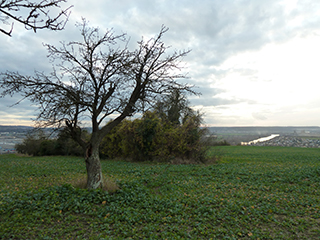Prochain point : lat=""48.995801"" lon=""1.855459""

Panorama over Juziers
Hedgerows: a cornerstone of the countryside...
Hedges play an important role in landscape diversity. In addition to being home to numerous wild species, they also change with the seasons and the different flowers as well as on the arrival of the autumnal colours. In short, hedges are not just used to surround gardens: they also contribute to the atmosphere of the countryside.
... that are also an environmental necessity
Hedges come in different shapes and sizes, and their appearance is as varied as their potential uses. The living hedge (see below) consists of a mixture of wild species. It plays a crucial ecological role as a home for birds, mammals, insects and reptiles. In addition, living hedges function as a windbreak: the protection they provide lengthwise can be up to twenty times greater than their height. This means they can help shelter crops and animals from weather hazards, and farm buildings and dwellings from various elements.
Hedges also play a role in regulating water and act as a plant barrier. When planted across a slope, they reduce runoff and encourage water to infiltrate the soil. As a result, they prevent the erosion of agricultural soil and gardens, reduce the risk of mudslides and limit flooding. Fruit trees are also a common feature of the landscape here, and are used to delimit fields: in the foreground we can see two superb vicar pear trees.
The old vineyards
The chalky hillside and siliceous plateau have been conducive to cultivating vines for centuries. The slopes along the Seine have been covered with vineyards since the Middle Ages. In 1789 there were 5,500 acres planted with vines in the district of Mantes. They extend over more than a fifth of the territory of Juziers. The wine in this region has a long history and an excellent reputation, and is exported even to England.
At the beginning of the twentieth century, the onset of phylloxera (a disease caused by parasitic aphids) - together with competition from imported wines transported by rail and the uneven quality of the local crops - put an end to winegrowing. But we can still discern traces of the past in place names in the villages (such as ‘Rue des Grandes Vignes’) and the architecture of the houses: the winegrowers' homes in the hamlet of Ablemont, for instance, have cellars dug into the limestone. Nowadays no more vines criss-cross the slopes of the Seine and Mantois valley. However, some wistful individuals still tend a handful of vines, and some communities have replanted vineyards with the help of the Vexin Français Regional Park.





